Vectors
40. Introduction to vectors
| Definition 40.1. A vector is a column of
two, three, or more numbers, written
in general.
|
We will always deal with either the two or three
dimensional cases, in other words, the cases n = 2
or n = 3, respectively. For these cases there is a geometric description of
vectors which is very useful. In
fact, the two and three dimensional theories have their origins in mechanics and
geometry. In higher
dimensions the geometric description fails, simply because we cannot visualize a
four dimensional
space, let alone a higher dimensional space. Instead of a geometric description
of vectors there is
an abstract theory called Linear Algebra which deals with “vector spaces”
of any dimension (even
infinite!). This theory of vectors in higher dimensional spaces is very useful
in science, engineering
and economics. You can learn about it in courses like MATH 320 or 340/341.
40.1. Basic arithmetic of vectors
You can add and subtract vectors, and you can multiply them with arbitrary real
numbers. this
section tells you how.
The sum of two vectors is defined by
(48)

and

The zero vector is defined by

It has the property that

no matter what the vector  is.
is.
You can multiply a vector  with
a real number t according to the rule
with
a real number t according to the rule

In particular, “minus a vector” is defined by

The difference of two vectors is defined by

So, to subtract two vectors you subtract their components,

 40.2 Some GOOD examples
40.2 Some GOOD examples


 40.3 Two very, very BAD
examples. Vectors must have the same size to be added, therefore
40.3 Two very, very BAD
examples. Vectors must have the same size to be added, therefore

Vectors and numbers are different things , so an equation
like
 is nonsense!
is nonsense!
This equation says that some vector (![]() ) is equal to some number (in this case:
3). Vectors and numbers
) is equal to some number (in this case:
3). Vectors and numbers
are never equal!

40.2. Algebraic properties of vector addition and multiplication
Addition of vectors and multiplication of numbers and vectors were defined in
such a way that the
following always hold for any vectors  (of the
same size) and any real numbers s, t
(of the
same size) and any real numbers s, t
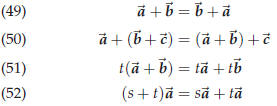 |
[vector addition is commutative] |
| [vector addition is associative] | |
| [first distributive property] | |
| [second distributive property] |
![]() 40.4 Prove (49). Let
40.4 Prove (49). Let  and
and  be two vectors, and consider both
possible ways of
be two vectors, and consider both
possible ways of
adding them:

We know (or we have assumed long ago) that addition of
real numbers is commutative, so that 
 , etc. Therefore
, etc. Therefore

This proves (49).
![]()
![]() 40.5 Example. If
40.5 Example. If
 and
and  are
two vectors, we define
are
two vectors, we define

Problem: Compute  and
and
 in terms of
in terms of
 and
and  .
.
Solution:

Problem: Find s, t so that

Solution: Simplifying  you find
you find

One way to ensure that  holds is therefore to choose s and t to be the solutions of
holds is therefore to choose s and t to be the solutions of

The second equation says t = −3s. The first equation then
leads to 2s + 3s = 1, i.e.  . Since
. Since
t = −3s we get  . The solution we have found
is therefore
. The solution we have found
is therefore

![]()
40.3. Geometric description of vectors
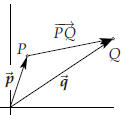 |
Vectors originally appeared in mechanics, where they represented forces:
a force acting on some object has a magnitude and a direction. Thus a force can be thought of as an arrow, where the length of the arrow indicates how strong the force is (how hard it pushes or pulls). So we will think of vectors as arrows: if you specify two points P and Q, then the arrow pointing from P to Q is a vector and we denote this vector by The precise mathematical definition is as follows: |
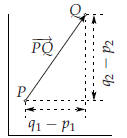 two pictures of the vector  |
Definition 40.6. For any pair of points P and Q whose coordinates are
 and and
 one defines one definesa vector  by by
If the initial point of an arrow is the origin O,
and the final point is any point Q, then the vector
|
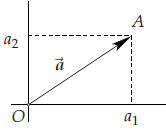 |
If  and and
 are the position vectors of P and Q,
then one can write are the position vectors of P and Q,
then one can write  as as
For plane vectors we define
says that the length of the vector
distance from P to This formula is also valid if P and Q are points in space.
This vector is the position vector of the point R whose coordinates are (6, 3). Thus |
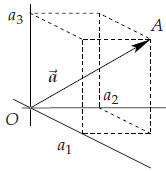
position vectors in the plane |

The distance from P to Q is the length of the vector
distance P to |
 |
![]()
![]() 40.8 Example. Find the distance between the points A and B whose position
vectors are
40.8 Example. Find the distance between the points A and B whose position
vectors are 
and  respectively.
respectively.
Solution: One has

![]()
| Prev | Next |

 is
defined by
is
defined by

 is called the
is called the
 . The old
. The old 


